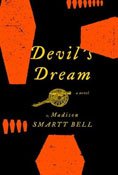At first glance, a novel on the life and times of Nathan Bedford Forrest may seem like a polarizing tale, but in "Devil's Dream" (Pantheon Books, 2009, $26) Madison Smartt Bell, a Nashville native, weaves an insightful story that reveals two sides of the controversial Confederate lieutenant general, slave trader and skilled cavalryman.
The story follows the triumphs and defeats of Forrest in war and in life.
The action portrays both moral and amoral moments of Forrest's life. Bell's Forrest isn't exactly irresponsible, but he does often throw accountability and responsibility to the wind for better or worse.
Bell's composition of various Civil War battles is picturesque, whether he's describing the bucolic countryside of Mississippi (in which much of the novel takes place) or Tennessee. The description of nature remains idyllic throughout, despite the human barbarity of war that invades it.
Many historians have shown that Forrest was a key figure in the Ku Klux Klan's formation and that he served as the first grand wizard. Bell's Forrest acts often in a brutish manner, but "Devil's Dream" does not so much as mention the KKK until the chronology of Forrest's life at the end of the book. Rather, much of the story revolves around his life before and during the Civil War.
The author presents Forrest as a humble, conflicted family manand as a godless dragoon bent on cutting down all his enemies. Bell does so deliberately, taking pains to paint Forrest as human, exhibiting both virtue and vice.
Bell uses the fictional character of Henri, a spiritual ancestor of Haitian Revolution leader Toussaint L'ouverture, to provide a third-person account of Forrest. In "Devil's Dream," Forrest meets Henri in the dark Kentucky night as the future Confederate hero is mustering forces for the imminent war. Henri, a runaway revolutionary, essentially has no other option than to fight under the Stars and Bars.
Blacks fighting for the South in the Civil War might be hard to fathom, but Forrest did, in fact, offer freedom to any of his slaves who volunteered to fight for him and 45 accepted. An inherent tension between social classes plays heavily into the story, mostly through the separate thoughts of Henri and Forrest.
Henri isn't the only black to fight under Forrest in "Devil's Dream"; the characters of Jerry, an older man who cooks for the regiment, and Matthew, a young man whose skin is not quite black and not quite white, both fight for the Confederate States of America.
The various auxiliary characters (soldiers, slaves or otherwise) complement Forrest, and many times their stories are absolutely true. Fortunately, Bell's chronology at the book's end gives the reader some means to sift fact from fiction.
Catharine is the enslaved maid of the Forrest family, and eventually, Forrest's mistress. Forrest cannot help but love Catharine, despite his love for his wife, Mary Ann, and the prefabricated racial hierarchy of the 1850s South. Forrest and Catharine's relationship grows complicated and results in a child who Forrest will come to know well.
The fictitious stories of those closest to Forrest, from his extended family to the slaves bought over the years, intertwine closer than history dictates, but Bell shapes narratives that afford more than simply a dated soap opera; he tells the stories of the region's grisly past to which many southerners can relate.
Forrest, in reality, is often associated with war crimes, particularly a Confederate attack on unarmed black soldiers at Fort Pillow in Henning, Tenn. The fort was on the Mississippi River, and Bell's description of the bloody aftermath feels chillingly accurate.
"That slaughterhouse smell was thicker than ever in the back of Henri's throat. He raised a hand to shade his eyes and saw that it wasn't only the sun that reddened the river. Thick and viscous as molasses, the Mississippi was running blood as far as he could see," Bell writes.
An interesting aspect of Bell's approach to the Civil War era is Henri's asides to the afterworld, where he becomes cognizant of the Old Ones, who the reader can assume to be the ancient spirits Native Americans believe created the world. These abstractions happen independently of the story and sometimes during the heat of the battle, as when Henri sees the Old Ones directly before an artillery shell bombards Forrest's horse.
Soldiers, black and white, comprise the inhabitants of this after-world, and their words provide a frame of reference for their fates. Their destinations shed light on the repercussions of their first lives.
While tenuous at times, Bell manages to give a realistic glimpse of the lives of both blacks and whites during the Civil War. Anyone interested in looking at human inter-dependencies and disparities of the times should read the somber but telling pages of "Devil's Dream."



Comments
Use the comment form below to begin a discussion about this content.
comments powered by Disqus